Following my two articles on Kanban graphs explained to children, I was asked if I could clarify a few things about the use of limits in Kanban. Impossible to write an article on limits explained to children, those who have them know. So I’m simply going to try to explain what I know and what I understand about limits in Kanban. The specialist being obviously Laurent, his blog and his book on this subject.
What is the purpose of setting a limit? And how do you know what limit to set?
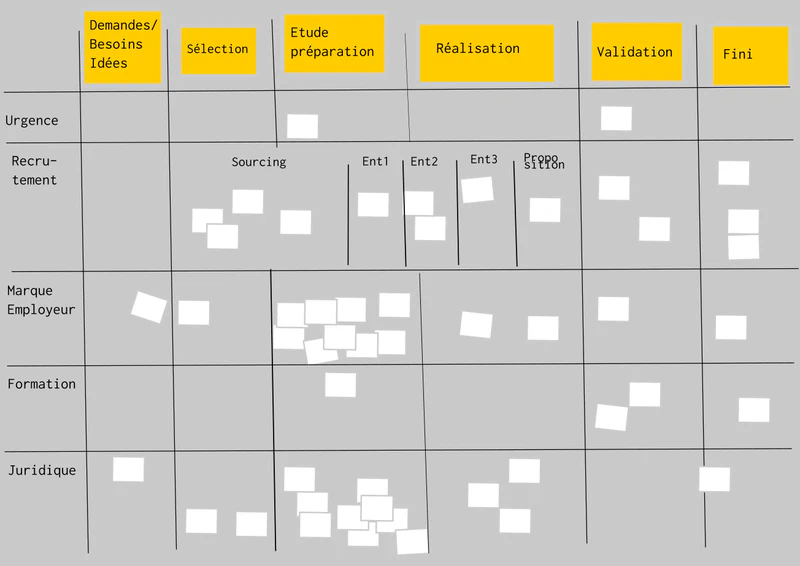
To explain this article I will use as an example a Kanban as presented during the Wake Up RH breakfast which I simplify (no column owner, no exit criteria). HR Kanban therefore, around an HR team. You can click on the images to enlarge them.
To explain this article I will also use, when I can, a fairly classic analogy between a Kanban flow and a watercourse. The goal is to provide you with a metaphor.
In short, when you start a Kanban it’s often first visual management that reveals the flow of your activity, of your value creation. Then we add a limit to constrain the flow. This is a decisive action that has a purpose: limit inventory, accelerate delivery, not overload a stage, etc. A limit is never free or random. What limit to set? The limit is the means. What goal are you pursuing? Some examples below.
#1 Start finishing, stop starting?
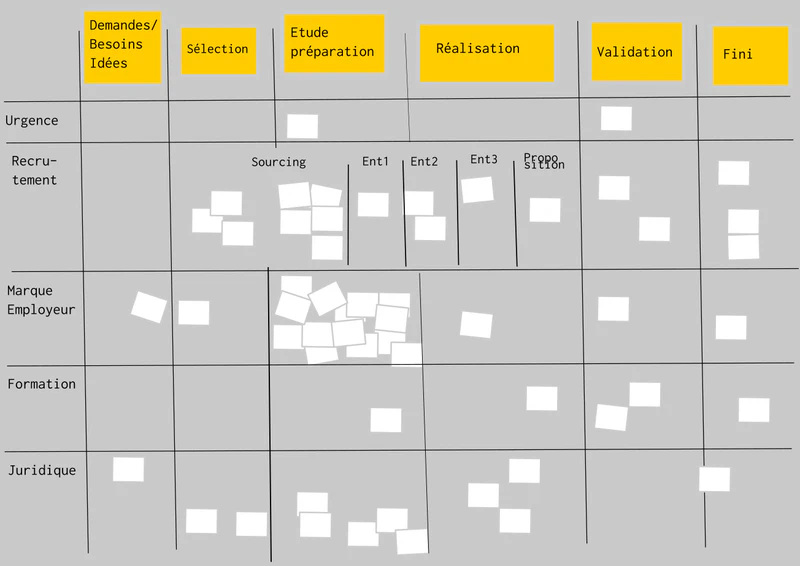
You’re in the fairly typical case where one of your stages gets clogged: we love starting things, but we rarely like finishing them. We lose focus, we get scattered. In this case we can place a limit. The purpose of this is to limit work in progress on the incriminated stage to force ourselves to finish things before starting others.
Watercourse metaphor?
Your activity, your value creation is like a long course that spreads greasily across the plain, until it no longer flows, until it stagnates. If you limit the size of the watercourse, if you dig a fairly tight ditch through which the water must pass, the flow accelerates, the water moves forward. There is less on the surface, but it goes much faster, and in total the volume of water that has passed through is the same or even much larger. Finally, as always, the first drop of water to arrive at the other end of the plain arrives much faster if the ditch is narrow. But the water can be violent because it is constrained, watch out for shocks related to the limit.
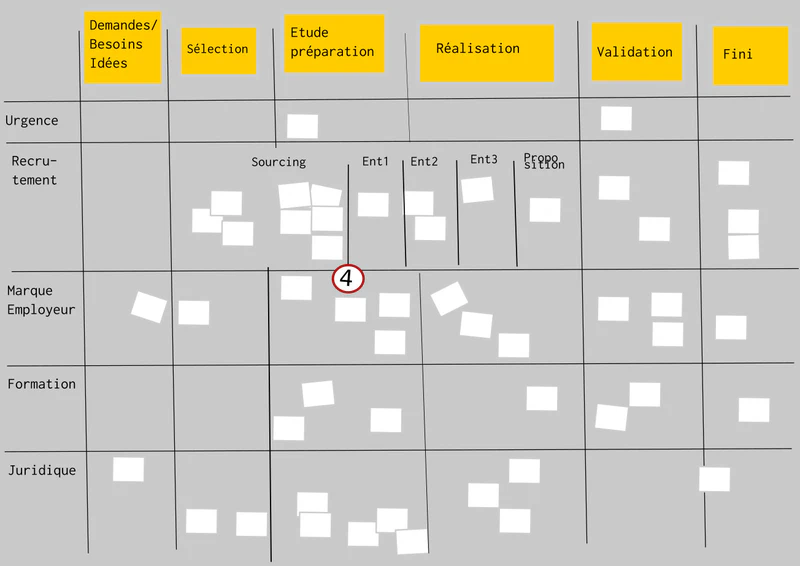
HR Kanban?
In the example of the attached images, we have plenty of ideas and requests concerning the employer brand. We think, we study, but we start too little. We should finish having things to prepare, and start doing some of them. We imagine placing a limit on preparation: unclog, force ourselves to start things or not to prepare others before dealing with one of the four elements declared in the “study/preparation” column. In this scenario another option would have been to better perform the selection action: by injecting appropriately into the flow. Or perhaps to anticipate the preparation bottleneck by placing a limit on selection. It’s up to you to try.
#2 Apply a strategy to your capacity to do?
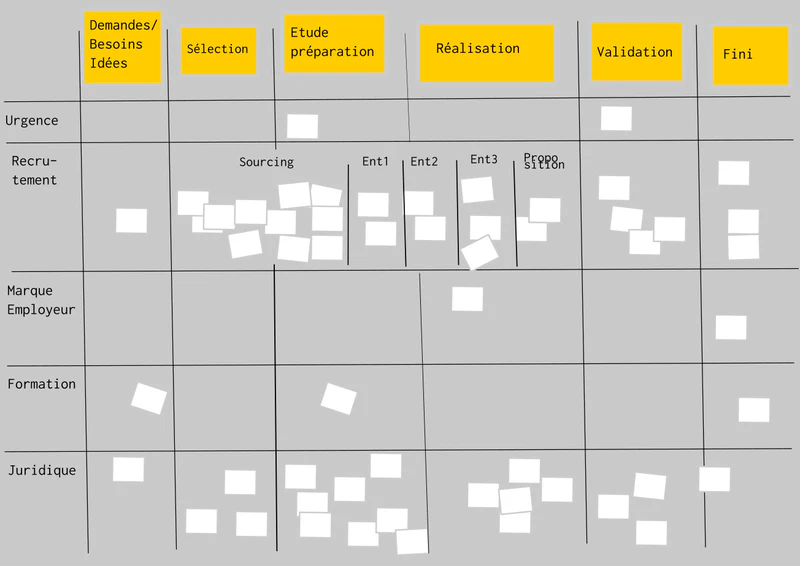
You’re in the case where your capacity is not distributed according to your strategy, your needs. For example you have three areas of activity and everyone is investing in area #1. However, identical investment would be needed in the three areas. You limit the activity of the different areas to ensure that it is better distributed among the different areas. (You could combine the first two scenarios: everyone is only investing in area #1, starting lots of things, finishing nothing). The limit will better distribute and push to finish.
Watercourse metaphor?
The watercourse that flows through the plain was initially made to irrigate three of your fields. But the water is idle, it has chosen the easiest path and it only flows to one of the three fields. If you constrain this easy path by limiting the possible flow, the water has no choice but to take the passages to the other fields.
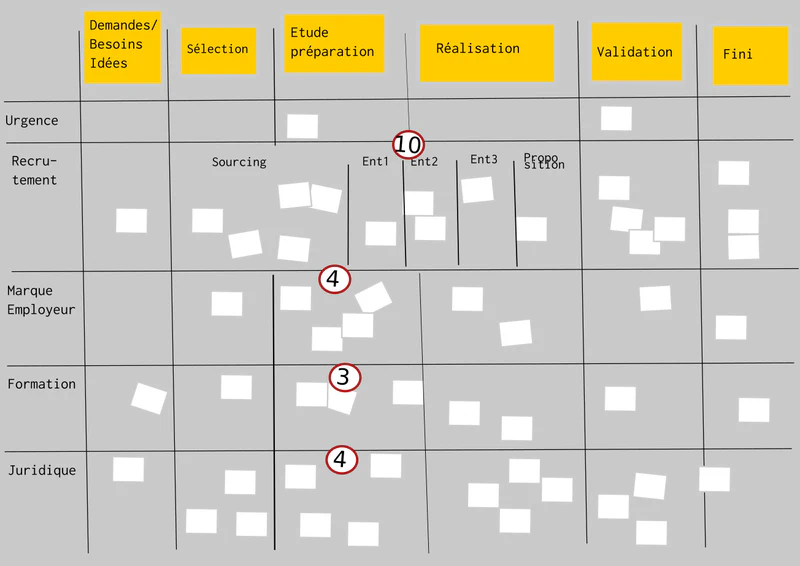
HR Kanban?
In the example of the attached images, the whole team rushes to legal (but why on earth?) and to recruitment, leaving the employer brand and training fallow. We could try to balance, if it makes sense for us, by distributing limits that constrain activities on other areas (no ladies and gentlemen, if your teams are in a healthy environment they don’t stop working, or work less, if the work makes sense we like to dive into it). These are only examples: don’t follow these numbers or this Kanban, do the complete approach at your place.
#3 Restore an imbalance of forces present?
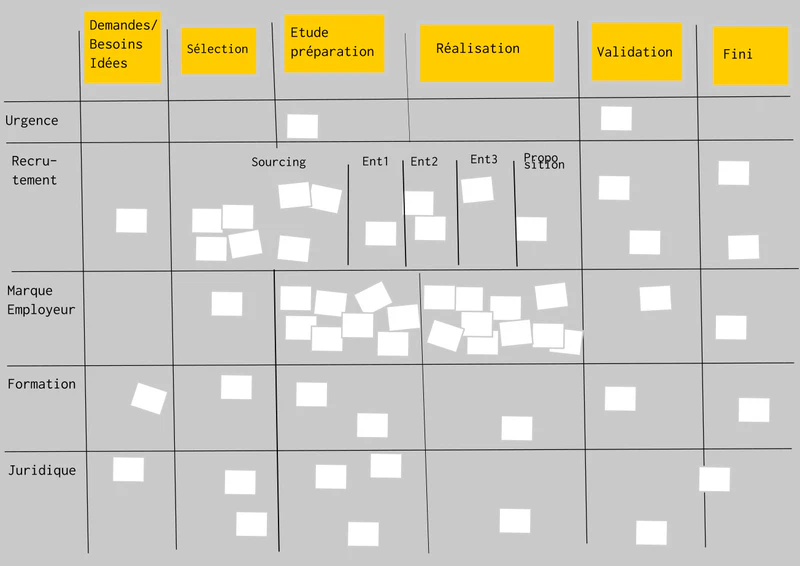
This is also a question of imbalance in the distribution of forces present, but not a distribution according to areas, but according to stages. You have, let’s say, ten people who think, cogitate, write the activities to be done, and two people who do them. Ideas, cogitations, writings abound, but accumulate and pile up, because the two people who do them are no match for the ten who feed them. It’s a shame because quickly the ideas, the cogitations, decline, expire. It’s a wasted investment. Here we place a limit upstream of the implementation stage, on the cogitation stage, to avoid a useless accumulation, their expiration, to again not work for nothing, or for little, and to direct this energy to a more relevant place.
Watercourse metaphor?
No point in watering your fields too much with the watercourse: they can’t ingest more water than their capacity and this water is wasted. Better to limit it (like a dam) to use it elsewhere.
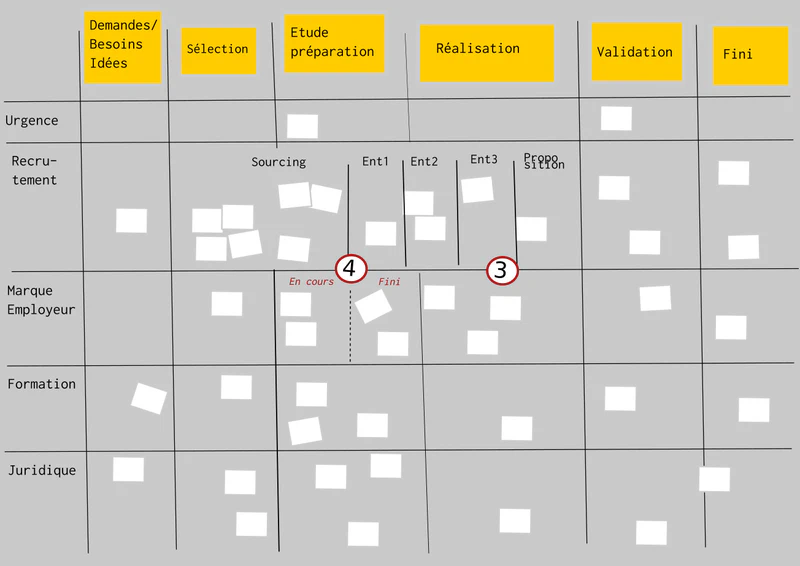
HR Kanban?
Caroline, Marie-Claire, Bénédicte, Simon, André, and Martha are consultants hired to revive the employer brand. They support Johanna and Natasha on this mission. Vincent and Patrick do all these requests, when they can, because Patrick also handles customer support. In fact, requests, ideas, accumulate in the “study/preparation” box, and also in the “implementation” box. We pushed Vincent and Patrick to start things, but for them impossible to finish them, not enough hands. (It’s even more visible if we use pull flows as in this article). Our option: place a pull flow (sub-columns in progress and done) to make this overload visible between two imbalanced forces present, and a limit on the upstream part “study/preparation” to not do too much, a limit on the “implementation” part to ensure the team stays focused. Thus several effects: no longer need so many consultants… or the consultants start doing, implementing too, or they share on another activity. You could perhaps have not set a limit by growing your implementation team. All of this remains hypotheses.
#4 Don’t forget low limits
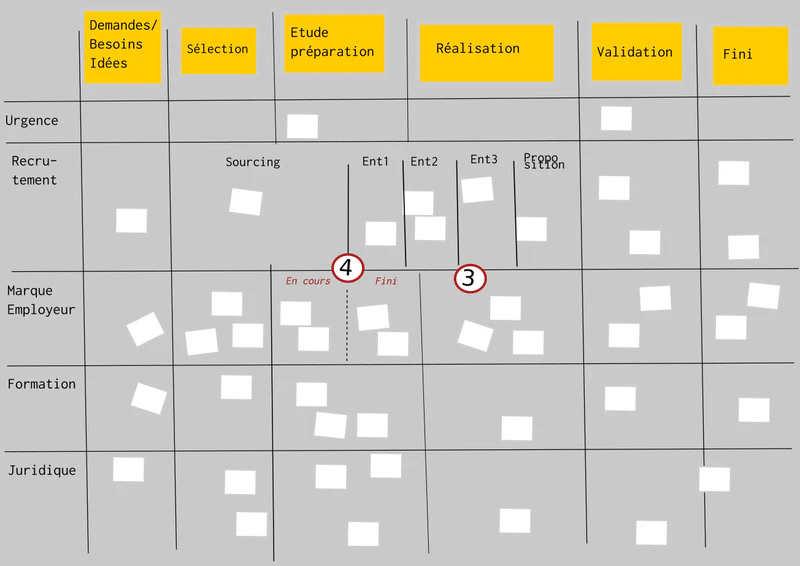
To guarantee the pace of the flow we can constrain it, but we must not forget to feed it too. You can have low limits. But you may need to irrigate your fields at minimum every day. If no one has ideas anymore, doesn’t cogitate, suddenly the two people who were implementing (in our previous example) find themselves short of material. You may need to ensure you advance on legal matters, or in a portfolio kanban of projects want at minimum one or two pure innovation projects, etc. Sometimes you have to think about ensuring a minimum flow.
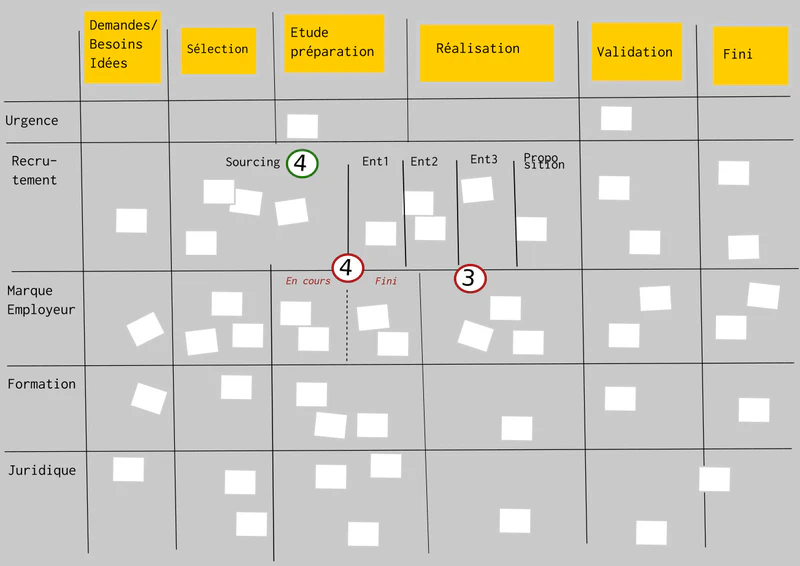
Here to ensure that a minimum of candidates are seen in interviews, we place a low limit on “sourcing” which must be done on at least four elements.
#5 Ensure the entire flow is limited?
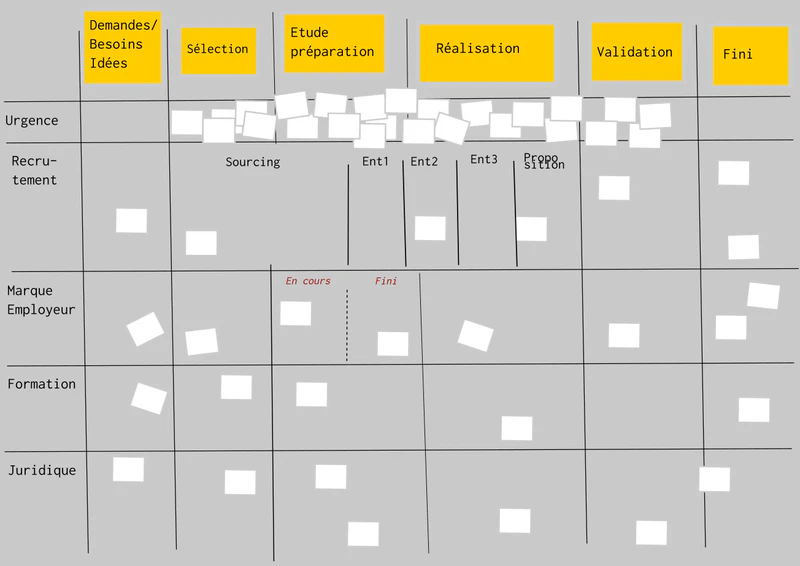
If you tried to place an “urgent” line (which we often call “expedites” in kanban) to highlight urgent matters to deal with, this may have happened to you… (see image on the left). It’s perhaps human. Everything has become urgent, emptying this designation of its meaning. So to fix this you would want to place limits on all columns, or even further limit the number of elements by allowing less than one per column.
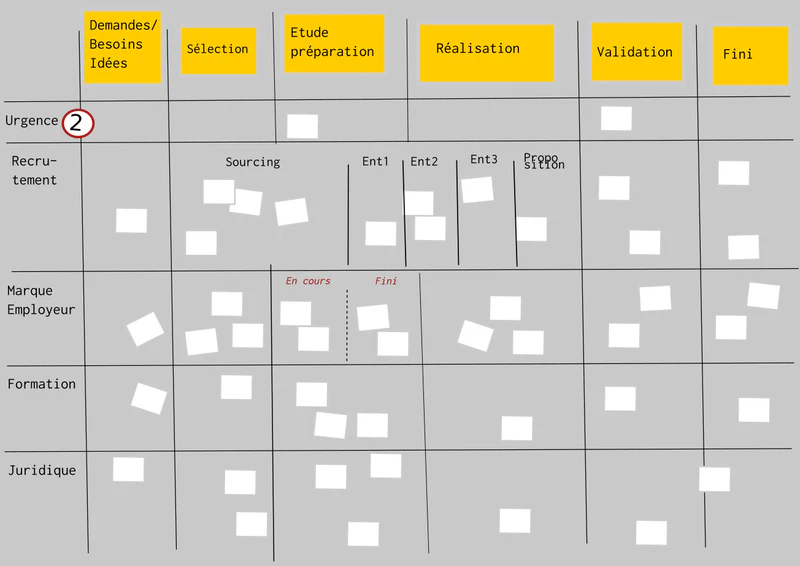
In this case it’s very constraining but you can place a limit at the beginning of the line.
These five examples are examples as their name indicates. They are frequent, but they are far from limiting the scenarios.
When do I suggest to a team to set limits?
The first thing is to make the activity, the value creation, visual. At the beginning there are therefore surely no limits. Unless you already have limits in your flow, but then you’re already doing Kanban, it’s not the beginning. Yet some of you will say that without limits it’s not yet a kanban but “simply” visual management. They may be right, and visual management is very good. I suggest you first stick to reality, let some time pass to observe the representation of your flow and draw lessons from it, then afterwards (a few weeks or months later?) start placing limits. These limits must have a meaning, a goal, a reason to exist. I almost suggest writing it somewhere: “The purpose of this limit is to …”.
Is my limit the right one (in granted capacity)?
I’m unable to tell you to apply this or that formula to define the “right” limit. In my view it’s the result of observing your flow that makes you deduce the right limit to apply. It should be rational: based on the number of people working in the “column”, on the activity. Based on the skills and multidisciplinarity of these people. But also on the type of elements in your value creation flow. Finally and above all on the meaning this limit pursues. It is therefore information to be defined according to the context that will emerge quite naturally and that can be modified, calibrated.